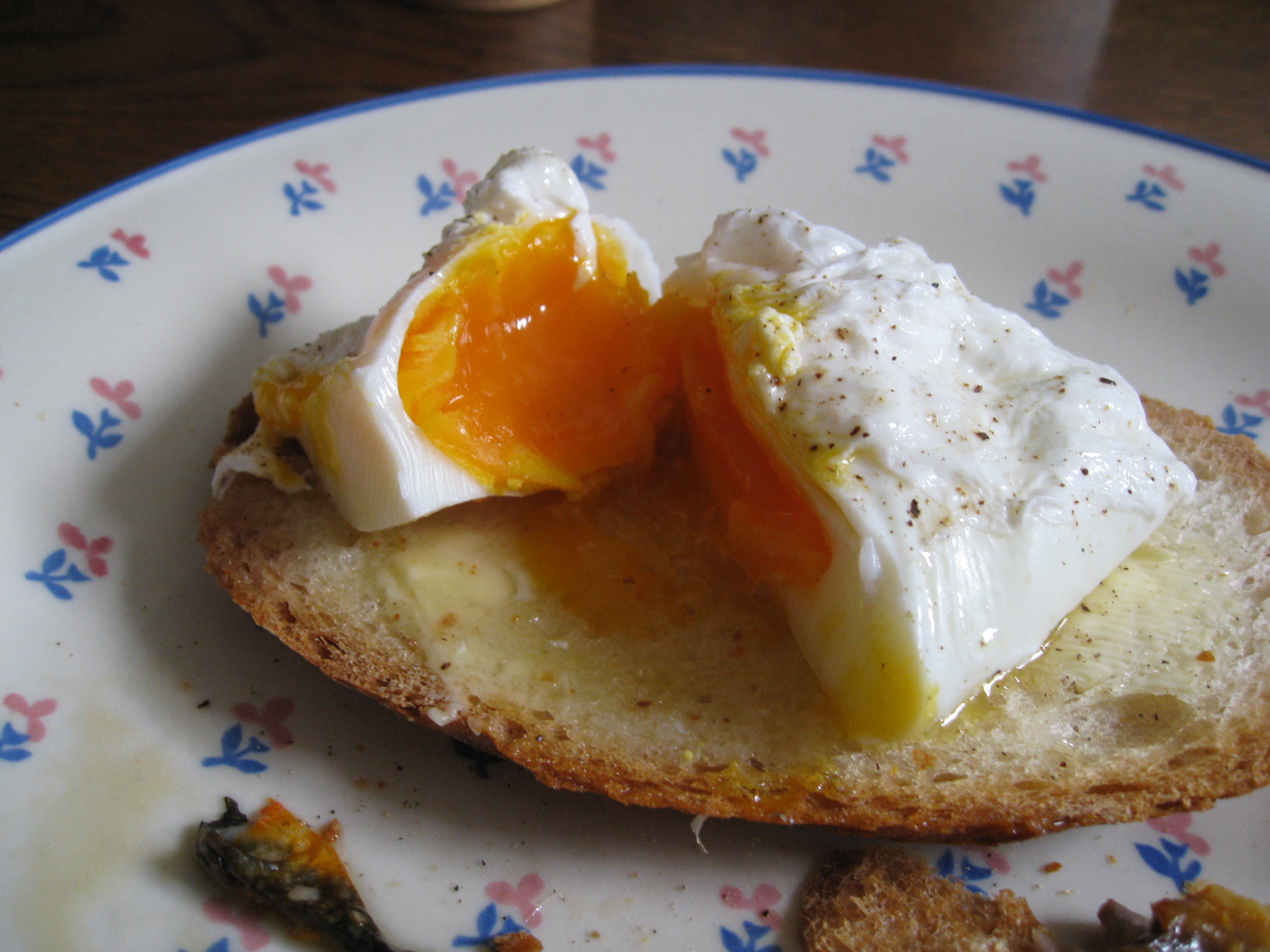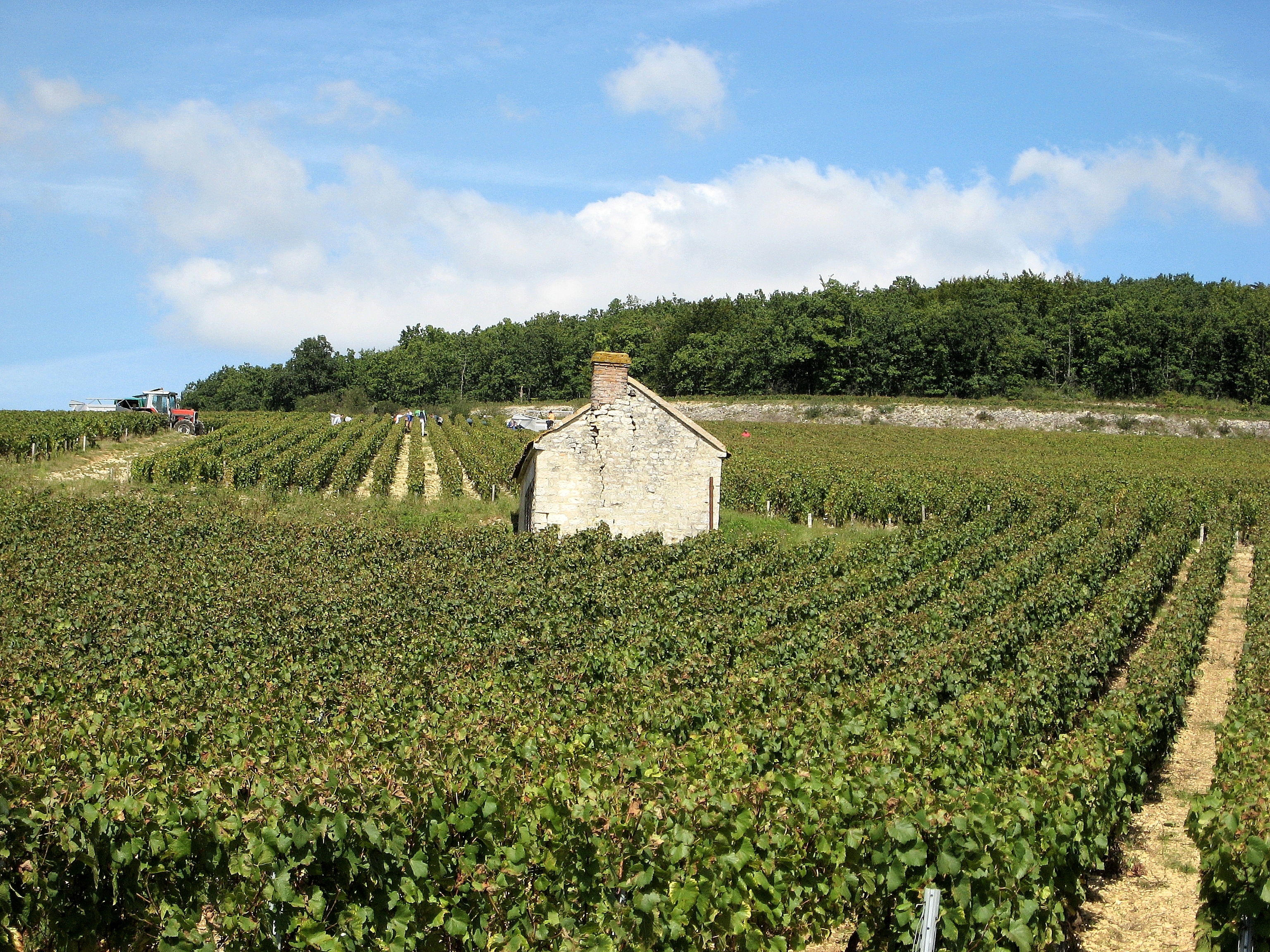|
Oeufs En Meurette
Oeufs en meurette is a traditional dish from Burgundian cuisine based on poached eggs and meurette sauce or bourguignon sauce. Description The dish is made with poached eggs accompanied by a meurette sauce/bourguignon sauce (made up of Burgundy red wine, bacon, onions and shallots browned in butter) and served with toasted garlic bread. It is the main dish of the Château du Clos de Vougeot, being the only dish served at receptions and weddings organized there. See also * Burgundy wine * Egg (food) Humans and other hominids have consumed eggs for millions of years. The most widely consumed eggs are those of fowl, especially chickens. People in Southeast Asia began harvesting chicken eggs for food by 1500 BCE. Eggs of other birds, such ... * List of brunch foods * Poached egg References External links Recipe for Eggs Meurette (French Wiki Books - in French)* Vin et cuisine (French Wiki - in French) * Cuisine bourguignonne (French Wiki - in French) French ... [...More Info...] [...Related Items...] OR: [Wikipedia] [Google] [Baidu] |
Burgundy
Burgundy ( ; ; Burgundian: ''Bregogne'') is a historical territory and former administrative region and province of east-central France. The province was once home to the Dukes of Burgundy from the early 11th until the late 15th century. The capital, Dijon, was wealthy and powerful, being a major European centre of art and science, and of Western Monasticism. In early Modern Europe, Burgundy was a focal point of courtly culture that set the fashion for European royal houses and their court. The Duchy of Burgundy was a key in the transformation of the Middle Ages towards early modern Europe. Upon the 9th-century partitions of the Kingdom of Burgundy, the lands and remnants partitioned to the Kingdom of France were reduced to a ducal rank by King Robert II of France in 1004. The House of Burgundy, a cadet branch of the House of Capet, ruled over a territory that roughly conformed to the borders and territories of the modern administrative region of Burgundy. Upon the exti ... [...More Info...] [...Related Items...] OR: [Wikipedia] [Google] [Baidu] |
Poached Egg
A poached egg is an egg that has been cooked outside the shell by poaching (or sometimes steaming). This method of preparation can yield more delicately cooked eggs than higher temperature methods such as boiling. Poached eggs can be found in several dishes. Preparation The egg is cracked into a cup or bowl of any size, and then gently slid into a pan of water at approximately and cooked until the egg white has mostly solidified, but the yolk remains soft. The ideal poached egg has a runny yolk, with a hardening crust and no raw white remaining. In countries that mandate universal salmonella vaccination for hens, eating eggs with a runny yolk is considered safe. Broken into the water at the poaching temperature, the white will cling to the yolk, resulting in cooked egg white and runny yolk. A chicken egg contains some egg white that may disperse into the poaching liquid and cook into an undesirable foam. To prevent this, the egg can be strained before cooking to remove the t ... [...More Info...] [...Related Items...] OR: [Wikipedia] [Google] [Baidu] |
Meurette
() is: *a red wine sauce cooked with bacon, onions, shallots, mushrooms and various spices. This sauce used in ''oeufs en meurette'' and many other preparations in French cuisine French cuisine is the cooking traditions and practices of France. In the 14th century, Guillaume Tirel, a Court (royal), court chef known as "Taillevent", wrote ''Le Viandier'', one of the earliest recipe collections of medieval France. In .... *a regional term for the fish stew with the generic name matelote.Montagné, pp. 612–613 References Sources * * {{France-cuisine-stub French sauces Stews ... [...More Info...] [...Related Items...] OR: [Wikipedia] [Google] [Baidu] |
Burgundy Red
Burgundy ( ; ; Burgundian: ''Bregogne'') is a historical territory and former administrative region and province of east-central France. The province was once home to the Dukes of Burgundy from the early 11th until the late 15th century. The capital, Dijon, was wealthy and powerful, being a major European centre of art and science, and of Western Monasticism. In early Modern Europe, Burgundy was a focal point of courtly culture that set the fashion for European royal houses and their court. The Duchy of Burgundy was a key in the transformation of the Middle Ages towards early modern Europe. Upon the 9th-century partitions of the Kingdom of Burgundy, the lands and remnants partitioned to the Kingdom of France were reduced to a ducal rank by King Robert II of France in 1004. The House of Burgundy, a cadet branch of the House of Capet, ruled over a territory that roughly conformed to the borders and territories of the modern administrative region of Burgundy. Upon the extinctio ... [...More Info...] [...Related Items...] OR: [Wikipedia] [Google] [Baidu] |
Shallot
The shallot is a cultivar group of the onion. Until 2010, the (French red) shallot was classified as a separate species, ''Allium ascalonicum''. The taxon was synonymized with '' Allium cepa'' (the common onion) in 2010, as the difference was too small to justify a separate species. As part of the onion genus ''Allium'', its close relatives include garlic, scallions, leeks, chives, and the Chinese onion. Etymology and names The names '' scallion'' and ''shallot'' are derived from the Old French ''eschalotte'', by way of ''eschaloigne'', from the Latin ''Ascalōnia caepa'' or Ascalonian onion, a ''Ascalōnia caepa'' or Ascalonian onion, a namesake of the ancient city of Ascalon. The term ''shallot'' is usually applied to the French red shallot (''Allium cepa'' var. ''aggregatum'', or the ''A. cepa'' Aggregatum Group). It is also used for the Persian shallot or ''musir'' (''A. stipitatum'') from the Zagros Mountains in Iran and Iraq, and the French gray shallot ('' Allium os ... [...More Info...] [...Related Items...] OR: [Wikipedia] [Google] [Baidu] |
Clos De Vougeot
Clos de Vougeot, also known as Clos Vougeot, is a wall-enclosed vineyard, a ''Clos (vineyard), clos'', in the Burgundy wine region, and an ''Appellation d'origine contrôlée'' (AOC) for red wine from this vineyard. It was named for the River Vouge, which is in fact only a stream separating the village Vougeot from Chambolle-Musigny. At , Clos de Vougeot is the largest single vineyard in Côte de Nuits entitled to the Cru (wine)#Grand cru, grand cru designation, while Corton (wine), Corton in Côte de Beaune is the largest grand cru in Burgundy (region), Burgundy as a whole. History The Clos de Vougeot vineyard was created by Cistercian monks of Cîteaux Abbey, the order's mother abbey. The land making up the vineyard was purchased by the Cistercians, or donated to them, from the 12th century to the early 14th century. The initial vineyard consisted of donations in 1109 to 1115. The vineyard was complete, and a wall had been built around it, by the year 1336. It served as the ... [...More Info...] [...Related Items...] OR: [Wikipedia] [Google] [Baidu] |
Burgundy Wine
Burgundy wine ( or ') is made in the Burgundy region of eastern France, in the valleys and slopes west of the Saône, a tributary of the Rhône. The most famous wines produced here, and those commonly referred to as "Burgundies", are dry (wine), dry red wines made from pinot noir grapes and white wines made from chardonnay grapes. Red and white wines are also made from other grape varieties, such as gamay and aligoté, respectively. Small amounts of rosé and sparkling wines are also produced in the region. Chardonnay-dominated Chablis (wine), Chablis and gamay-dominated Beaujolais wine, Beaujolais are recognised as part of the Burgundy wine region, but wines from those subregions are usually referred to by their own names rather than as "Burgundy wines". Burgundy has a higher number of ' (AOCs) than any other French region, and is often seen as the most '-conscious of the French wine regions. The various Burgundy AOCs are classification of wine, classified from carefully deline ... [...More Info...] [...Related Items...] OR: [Wikipedia] [Google] [Baidu] |
Egg (food)
Humans and other hominids have consumed eggs for millions of years. The most widely consumed eggs are those of fowl, especially chickens. People in Southeast Asia began harvesting chicken eggs for food by 1500 BCE. Eggs of other birds, such as ducks and ostriches, are eaten regularly but much less commonly than those of chickens. People may also eat the eggs of reptiles, amphibians, and fish. Fish eggs consumed as food are known as roe or caviar. Hens and other egg-laying creatures are raised throughout the world, and mass production of chicken eggs is a global industry. In 2009, an estimated 62.1 million metric tons of eggs were produced worldwide from a total laying flock of approximately 6.4 billion hens. There are issues of regional variation in demand and expectation, as well as current debates concerning methods of mass production. In 2012, the European Union banned battery husbandry of chickens. History Bird eggs have been valuable foodstuffs since prehistory, ... [...More Info...] [...Related Items...] OR: [Wikipedia] [Google] [Baidu] |
List Of Brunch Foods
This is a list of brunch foods and dishes. Brunch is a combination of breakfast and lunch eaten usually during the late morning but it can extend to as late as 2 pm and 8 pm on the East Coast, although some restaurants may extend the hours to a later time. The word is a portmanteau of ''breakfast'' and ''lunch''. Brunch originated in England in the late 1800s, served in a buffet style manner, and became popular in the United States in the 1930s. Brunch foods and dishes The following foods are often served for brunch. * Açaí na tigela * Avocado toast * Bacon * Bagel – in New York City, the "bagel brunch" was popular circa 1900. The bagel brunch consists of a bagel topped with lox, cream cheese, capers, tomato and red onion. * Bagel and cream cheese * Biscuits and gravy * Blintz * Bread and toast with butter and jams * Breakfast sausage * Brunch casserole – a simple casserole prepared with bread, eggs and bacon * Cheese * Chilaquiles *Cinnamon rolls * Coffee ca ... [...More Info...] [...Related Items...] OR: [Wikipedia] [Google] [Baidu] |
Poached Egg
A poached egg is an egg that has been cooked outside the shell by poaching (or sometimes steaming). This method of preparation can yield more delicately cooked eggs than higher temperature methods such as boiling. Poached eggs can be found in several dishes. Preparation The egg is cracked into a cup or bowl of any size, and then gently slid into a pan of water at approximately and cooked until the egg white has mostly solidified, but the yolk remains soft. The ideal poached egg has a runny yolk, with a hardening crust and no raw white remaining. In countries that mandate universal salmonella vaccination for hens, eating eggs with a runny yolk is considered safe. Broken into the water at the poaching temperature, the white will cling to the yolk, resulting in cooked egg white and runny yolk. A chicken egg contains some egg white that may disperse into the poaching liquid and cook into an undesirable foam. To prevent this, the egg can be strained before cooking to remove the t ... [...More Info...] [...Related Items...] OR: [Wikipedia] [Google] [Baidu] |








